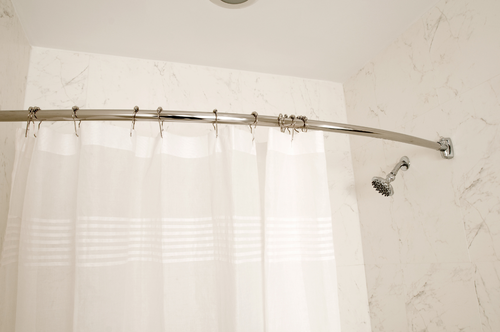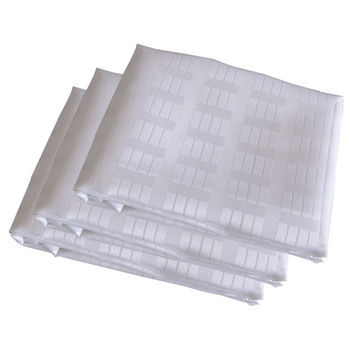At Access Rehabilitation Equipment, we commit to providing you and your loved ones solutions for life! Fitting your lifestyle, each aid and equipment is tailored to the unique challenges you are facing, so work with us to find the independence and mobility you want!

Having a shower curtain stick to you while showering is one of life's little annoyances. But with some simple tips and DIY tricks, you can solve this problem once and for all. Read on for our guide to keeping your shower curtain where it belongs – away from your body.
Why do shower curtains stick to you?
We’ve all felt the frustration of the 'shower curtain effect': when you start your shower and the cold, wet curtain clings to your body. This happens because the water flow creates air currents, drawing outside air into the shower enclosure. Since you’re enclosed by three walls, the only way for the outside air to enter is by going under or around the curtain. That's why it swells inwards and clings to you.
What can I use to weigh down my shower curtain?
There are several effective ways to weigh down a shower curtain to prevent billowing. Use things you already have around the house, or pick out a store-bought option that’s right for you.

- Install a curved rod: Swap out a straight shower rod for a curved rod, where the rod extends outward and away from you while you shower, so you have more room. Curved shower curtain rods create tension that holds the curtain taut and away from the shower area.
- DIY and make a weighted shower curtain: You can sew or clip weights like washers or coins into the bottom hem of the curtain. Or, you can also cut off the bottom hem of your existing shower curtain. Sew a channel and insert a rope, chain or line of weighted objects. This will pull the curtain downwards.
- Buy a weighted shower curtain: Make life easy for yourself and buy a weighted shower curtain. Our shower curtains are made from quality waterproof material with weights at the base.

Do weighted shower curtains work?
Yes, adding weight to the bottom of a shower curtain or buying a weighted shower curtain is a good way to stop the curtain from moving inward and sticking to you while you shower. The extra weight keeps the curtain tight, preventing it from blowing around air circulation or the spray from the shower.
What to avoid when buying a shower curtain?

When buying a new shower curtain, stay away from curtains made of plastic or vinyl, as these materials increase static cling. Opt instead for alternatives like polyester, PEVA, EVA, or natural fabrics such as cotton, linen, or hemp that don't build up as much static electricity.
How much bigger should a shower curtain be than the shower?
Ideally, your shower curtain should have at least 12 inches of overlap on both sides of your shower opening. This allows the curtain to form a bathtub-like enclosure.
Should shower curtains touch the floor?
Shower curtains should not touch or rest on the floor. Leave a 2-4 inch gap to prevent mildew growth, avoid transferring floor grime onto the curtain, and allow airflow for quicker drying between uses.
How can I stop my shower curtain from going mouldy?
Preventing mould buildup is key to keeping your shower curtain fresh. Make sure to fully extend the curtain after use so it can fully dry. Leave the bathroom door open or a window cracked to allow air circulation. Regularly clean the curtain with a disinfectant spray or washing machine cycle. And consider replacing plastic or vinyl curtains every 6-12 months as they are prone to accumulating mold over time.
How often should I wash a shower curtain?
For a fabric curtain, wash it monthly on a gentle cycle. For plastic/vinyl curtains, wipe them down weekly with a disinfectant cleaner. However, if you notice mold, discoloration, or a funky smell, that means it’s time for cleaning.
How to remove mould from shower curtain?
While throwing the shower curtain away may seem like the easiest option, there are still ways to remove mold if it has already formed. You can try:
- Soaking the curtain in a bleach solution: Mix one part bleach with three parts water in a bucket or bathtub. Submerge the curtain in the solution for several hours or overnight, then rinse thoroughly with water.
- Scrubbing with baking soda: Create a paste by mixing baking soda with a small amount of water. Apply the paste to the moldy areas of the curtain and scrub gently with a brush or sponge. Wash the curtain as usual and hang to air-dry.
- Using a mould removal spray: These sprays contain chemicals designed specifically to eliminate bathroom mold and mildew. Saturate the affected areas, allow it to sit per instructions, then rinse away the dead mold.
Can I wash my mouldy shower curtain in the washing machine?
Yes, you can machine wash fabric shower curtains on a gentle cycle. Add bleach or vinegar to help kill mould. For plastic/vinyl curtains, hand wash and air dry.
Conclusion
Don't let a clingy shower curtain ruin your bathing experience. With a few simple adjustments and some basic maintenance, you can enjoy a shower curtain that hangs properly and stays mould-free. Try one of our DIY tricks or invest in a quality weighted curtain or curved rod. With the right product and some extra care, you'll never have to wrestle with your shower curtain again!


 Providing solutions for life
Providing solutions for life







